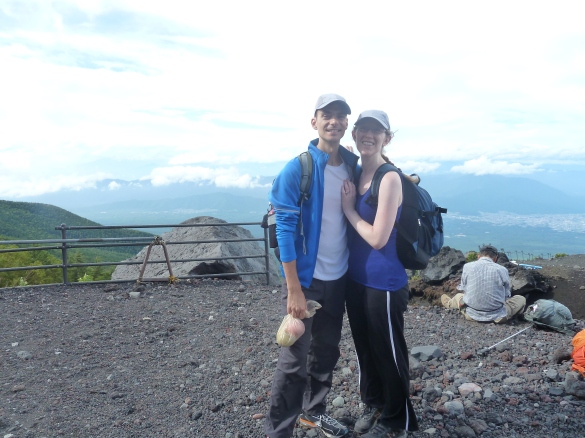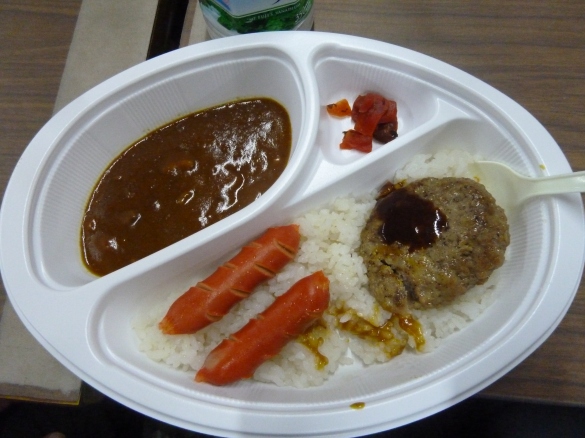“A wise man climbs Mt. Fuji once, but only a fool does it twice.”
Most literature on reaching the highest point in Japan contains this anonymously-accredited saying. I didn’t understand how dead-on these words until I neared the top. Devoid of context, it’s not too helpful. Even with context, which I’ll try to illustrate over the next two posts, it’s not too helpful. To fully appreciate just how perfectly those words sum up the mountain, you have to make the climb yourself.
Ascending Fuji is an amazing, unforgettable, once-in-a-lifetime experience that I have no intention of ever doing again.
We had always intended the Fuji-san climb to be one of our last great hurrahs before our year draws to a close, which made it all the more eerie when the time for the trip finally came. It was an event that always seemed to exist in the indefinite future. This mentality led us to our first big mistake: bringing our winter clothing back to the United States during our multi-wedding tour in April.
Before the trip, we assembled a hodgepodge of gear, some ours, some borrowed, some newly purchased. I equipped myself with tough hiking pants to pull over some cheap jogging pants, a long-sleeve tee, a water-resistant running jacket, hoodie, my spring-autumn light jacket, thin wool gloves, a baseball cap, a rolled-up poncho, and (since my size 13s make boot shopping difficult) tennis shoes. Katie bought some boots; borrowed pants and hat; and was ready to layer tank-top, t-shirt, sweater, jacket, and poncho. By and large, this wasn’t gear explicitly for mountain climbing, but we figured with enough layers we could protect ourselves from the most of the elements.
Typhoon winds delayed our original climb date, so we shifted our schedule around a bit. Rather than following up the climb with a second visit to Tokyo, we went to Tokyo first, hoping to tackle Fuji-san during the calm after the storm. The forecast looked clear for a Monday ascent and Tuesday descent. Our goal? Reach the hut at the 8th station that night, sleep, wake two hours before dawn, and make it to the summit to see the sunrise.
We woke up at Shinjuku station Monday morning, leaving our dry clothes with our hotel concierge, and hoping to reach the 5th station (where most climbs begin) by bus in the early afternoon. But the earliest opening on the schedule was at 5pm. We wouldn’t be able to start climbing until 7pm, which would put the majority of the climb in the dark. This is called “bullet climbing,” and isn’t recommended, both for the obvious safety reasons and for the obscured vistas.
So instead we hopped on a train to Otsuki, west of Tokyo, so that we could catch another train over to Kawaguchi Lake, north of the mountain, and then pick up a bus to the 5th station. This would take around 4 hours, but it was our only option if we still wanted to make the climb. Along the way we met two other gaijin from Spain, one from Madrid and one from Barcelona, who were in the same situation as us. This at least comforted us into knowing we weren’t going the wrong way.
Our climb began around 3pm. Later than intended, but still plenty of time to reach our station at a semi-reasonable hour. We’d have to hike the final few hundred meters in the dark, but we had headlamps for that exact situation.

Look how youthful and full of energy we were. This will make an interesting comparsion with our “after” photos.
The climb begins with a fairly flat hike along the midsection of the mountain from the 5th station to where the switchbacks start to make their steep way towards the summit. We walked with our Spanish friends for a short distance, but they quickly outpaced us.

Another view from the trail. For the first several hours, this is what we’d see whenever we look to our side.
Partway up the mountain is still higher than anything around you, so the view is immediately spectacular. The 5th station is at 2,305 meters, or over 7,500 ft, so even from the start you are high enough that the air is slightly cooler than it was down below.
During these early points, the trail was incredibly well-maintained. Katie and I have done some mountain hikes before, but mostly just American east and west coast stuff: Old Rag in Virginia, the Adirondacks in New York, or trails around Bend, Oregon. Nothing in the tallest-mountain-in-this-country, multi-day hikes. Still, I’d imagine that the Kilmanjaros and McKinleys of the world don’t have trails this wide and this impeccably groomed. At least during these early stages.
After a few hours, we reach a queue. The mountain never seemed crowded before, and I wouldn’t have called it crowded then, but the path had gradually narrowed more and more until people had to proceed single file, scrambling up steep rock paths, sometimes using your hands. The trail was starting to wear us out a little, so I didn’t mind the slower pace. However, now that our climb was feeling a little less aerobic, and since the sun was getting lower in the sky, we started adding layers.
We talked with the people around us, particular an American military family – two boys, two parents – who kept crossing our paths for the next couple days. The younger son, 13, was especially sociable. There was a real sense of comradery with our fellow climbers that made the bottleneck crowds tolerable. Sure, we’d grumble under our breath about the occasional person who tried (usually unsuccessfully) to cut ahead. But by and large there was an unspoken bond between us and everyone else sharing in this intense, singular experience.
The thin air started to slightly affect Katie. She had some shortness of breath, so our pace slowed a little more. I wasn’t feeling it, not yet, at least. Though I did notice that I wasn’t getting quite as much oxygen on deep breaths. That’s a strange feelings, one that starts to feel unnerving if you think about it too much.
We passed stations along the way, though we never rested much longer than a short breather or to spend 200 yen to use a bathroom. It was getting too cold and too dark. When we did stop, it was to take a moment to process how far we’d come. Far more clouds were below us than above us now. The sunset decorated them with vibrant color. The moon became visible low in the sky, but we were so far above the horizon at that point, it seemed below us.
Then the sun disappeared and our headlamps came on. We lost climbers as we went along, though if they turned back or simply stopped at earlier stations, I can’t be sure. In time we were more or less alone on the path. I wouldn’t call the darkness absolute – after all, we could see the flashlights of climbers above and below us, the lights of the town near the lake below, and the small cone illuminated in front of us – but all of those lights struggled in that much dark. Our headlamps let us see what we needed to see, no more. The only things reminding us we were on top of a mountain were the thin and cold air, the wind, and the knowledge that we’d only get to sleep if we kept climbing.
It was 10pm when we reached our hut. Thankfully we’d asked for a meal when we’d made the reservation, so we had some simple rice and curry (or in Katie’s case: rice, vegetables, and tomato sauce) waiting for us. We were shown to our “room,” essentially a shelf with dozens of sleeping bags laid side-by-side. We were told we’d get a wakeup call at 2 am.
Any shelter would do at that point. We were exhausted and the wind was starting to howl outside. And we still had 376 m to ascend before dawn.












Pingback: Our Kyoto Year | Mt. Fuji’s Summit and Descent (Day 2)
Pingback: Our Kyoto Year | Gion Matsuri (Part 2)- Japan’s biggest festival and float parade
Pingback: Our Kyoto Year | Tokyo (Part 1) – Swords and Sculptures